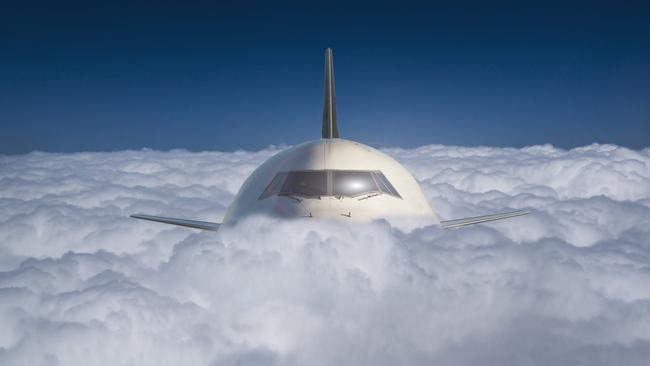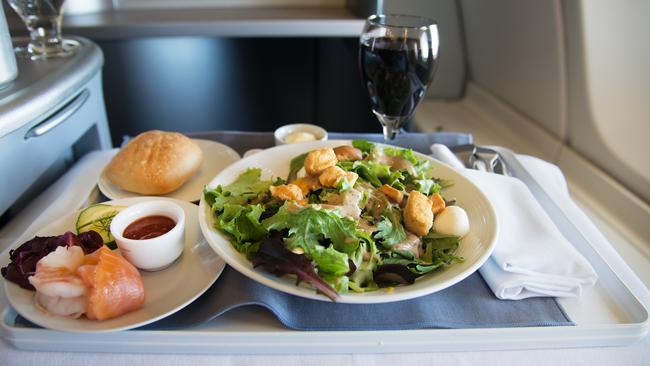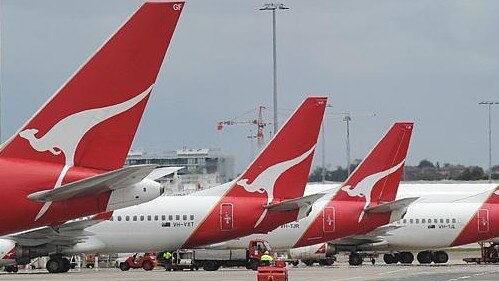Aviation: the science behind the world’s longest flights
Cauliflower, red lights and bone-broth tea are some of the measures being used amid a rethink of trips lasting 20 hours or more.

The Sonoran Desert is a pretty good place to research what ultralong non-stop flights do to the human body.
Airlines and scientists are studying the effects of spending 20 hours or more in an arid cabin at high altitude. They’re beginning to change everything from food service to cabin lighting and temperature to combat dehydration, jet lag and the sedentary effects of being belted into a seat for a day binge-watching movies.
Singapore Airlines is working with nutrition and health experts at Canyon Ranch here to devise new menus and on-board wellness programs for its 9534-mile (15,350km) non-stop trips between Newark, N.J., and Singapore, which will be the longest flights in the world when they launch in October. The airline will also add the long-distance wellness program to existing San Francisco and Los Angeles flights.
Out go potatoes; in comes cauliflower. Beverages are being selected to not only improve hydration but also promote bathroom trips to make sure people get up and move around to stimulate blood flow and stretch muscles.
Even portion sizes are being re-evaluated. “You are relatively inactive, so you don’t need as much to keep you sustained for 19 hours,” says Antony McNeil, Singapore’s food and beverage director.
For decades people have been flying to the other side of the world, typically stopping to make connections at a hub airport on another continent. But the growth in the airline industry in recent years has been ultralong nonstops. Newer aircraft like the Boeing 787 and Airbus A350 have the range and low operating costs to link cities directly.
In 2008, the average airline trip worldwide was 747 miles. Now it’s 863 miles, up 16 per cent, according to consulting firm Oliver Wyman’s PlaneStats.com.

About a year ago Qantas Airways launched Project Sunrise, an effort to prepare for hoped-for non-stop flights from Sydney to London and New York. The airline enlisted the University of Sydney to study the effects of long periods at high altitude and enticed Boeing and Airbus to deliver a plane with enough range to fly halfway around the world non-stop.
Qantas is already expanding beyond its Sydney-Dallas route, which at one time was the longest route in the world by miles. The airline started non-stop between Perth and London, a 17-hour trip, in March with a Boeing 787.
To learn more about passengers on long flights, Qantas enlisted volunteer frequent flyers to wear monitors on wrists and legs. It turns out there’s huge variation in passenger movement: Some passengers are active, others remain sedentary the entire trip.
Changes are already happening, such as delaying dinner on the evening departure from Perth to begin moving body clocks to London time. When it’s time to go to sleep, cabin lights turn amber and red, which facilitate rest. Blue and white lighting helps wake passengers up.
Flight attendants now adjust cabin temperature to facilitate sleep, too. Cooler temps help you power down.
Sleep patterns are crucial. Yet the ideal strategy remains unknown. Is it better to have one long sleep or two shorter sleep periods?
“There are a lot of knowns in ultralong haul, but there are also a lot of questions we need to ask,” says Phil Capps, head of customer product and service development at Qantas.
Singapore has run sleep- and eating-schedule trials on its San Francisco flights, which cover nearly 17 hours heading west. Passengers can sleep and eat when they want, says Betty Wong, Singapore’s vice president of in-flight services, but “we can suggest good times that you’ll want to rest.”

After months of menu planning by conference call, Singapore chefs came to Tucson to cook up 36 different dishes in three days with Canyon Ranch chefs. The Canyon Ranch side knows about the effects food can have on bodies. The Singapore side knows about the effects airlines can have on food. Food can be prepared eight to 10 hours in advance to get packed for shipping and then sit on planes 15 hours before being reheated.
Lightly sauteed spinach was stored in a heat pack for hours, then reheated for serving on a plane. It didn’t wilt.
But a Hollandaise made with yoghurt and egg yolks fell apart after it was cooked, chilled, packed and reheated. The recipe was modified to remove egg yolks and add béchamel sauce.
Since regulations prohibit serving raw fish in an airline environment, the prawns had to be poached. Vinegar and other elements of ceviche were added to a broth and the dish was labelled “ceviche style.”
Canyon Ranch worked to reduce the heaviness of meals and portion size to avoid peaks and troughs in blood-sugar levels — multiple, smaller portions are better than a big feast.
Instead of pureed or creamy potatoes that Singapore serves on existing long flights, chefs substituted riced cauliflower with turmeric and made it look like mashed potato for the ultralong trips. Cauliflower helps hydrate passengers. Turmeric is an anti-inflammatory that can counteract effects of long flights.
Likewise, the dessert menu will include angel food cake with blueberry compote that looks like cheese cake.

Singapore is also adding bone-broth teas because they’ll send people to the bathroom more frequently, forcing them to stretch.
Standard tricks of airline food applied as well. Lots of sauces are used to combat cabin dryness. Chicken thighs are used instead of breast meat because they’re more moist.
But Singapore is ditching other traditional tricks. Because tastebuds are weaker in the arid-dry aeroplane cabin, airline kitchens often load up on salt to give food more flavour. That leads to more dehydration for passengers. That can cause fatigue and headaches, muscle and joint tightness and aches, and leave you at greater risk of catching colds.
So the joint team of chefs worked on low-sodium dishes with strong-enough flavours for altitude.
The surviving dishes will go through one more test in Singapore, where the airline has a cabin mock-up on the ground that can be pressurised to better replicate the in-air experience. They’ll be offered as choices for passengers, along with traditional Asian food.
Another area under review with Canyon Ranch: exercise. Singapore, like many airlines, already has a video suggesting some in-seat stretching to relieve tension and stimulate blood flow. The airline is updating the video with input from Canyon Ranch and is considering whether to do more. “Not push-ups in the aisle,” Canyon Ranch CEO Susan Docherty says, “but more seated exercises.”
Qantas says it hasn’t ruled out having a trainer on-board to lead exercises.
WSJ


